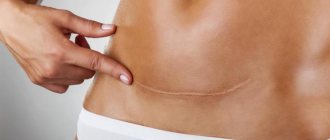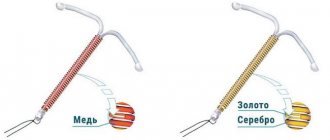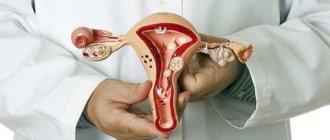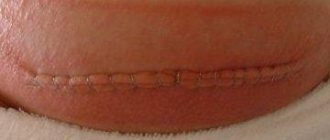Causes of ICN
During pregnancy, the cervix of the reproductive organ is a kind of closure, thanks to which the child is held inside the mother’s body. In some situations, there is an increased risk that it may open prematurely in a pregnant woman. In order to prevent such a pathological condition, a woman undergoes an operation - tightening the neck of the reproductive organ with sutures.
There are several reasons that can provoke dilatation of the cervix, and if identified, the doctor will decide to apply sutures. In some patients, the tissues of the cervix of the reproductive organ are too weak and this is due to their genetic characteristics of the body. As the unborn child grows, the load on the tissues increases significantly and at a certain point they may simply not be able to cope with it.
The risk of cervical dilatation also increases in those women who have an irregularly shaped organ with a cyst, so during pregnancy they are warned about their condition. The cause of ICI is often damage to the reproductive organ, its conization and changes in the hormonal levels of the female body. Those expectant mothers who have already encountered problems during a previous pregnancy should be attentive to their health. It is possible to make a correct diagnosis and identify this pathology after a vaginal examination by a gynecologist and an ultrasound scan. In some cases, to confirm ICI, special examinations are required, which must be completed from 12 to 25 weeks. How a woman with such a pathology will give birth, naturally or by cesarean section, is determined only by the doctor.
When are the stitches removed?
The time for removing sutures depends on the type of incision: a cosmetic suture is applied with self-absorbing threads that do not need to be removed. These threads will disappear on their own 70–80 days after a cesarean section. The interrupted suture with a vertical (corporal) incision is removed 7–10 days after birth. Many women worry about the pain of suture removal. In fact, it only takes a few minutes and is more likely to cause discomfort than pain.
The cosmetic suture is applied with self-absorbing threads that do not need to be removed
My friend gave birth to her son by caesarean section: her stitches were removed on the 10th day after the caesarean section. She said that some girls got rid of the stitch already on the seventh day after the operation.
Indications for suturing
Surgical treatment of ICI in expectant mothers is usually used in the following cases:
- Identification of the following pathological conditions of the body in the patient after a gynecological examination and ultrasound:
- incompetent cervix of the reproductive organ;
- softening and shortening of the uterine pharynx;
- opening of the cervical canal or internal pharynx by 20-30 mm;
- Presence in the woman’s history of premature labor and spontaneous miscarriages at a long term;
- The patient is pregnant with twins.
In some cases, suturing the cervix will have to be abandoned, since there are some contraindications to such an operation:
- detection of developmental defects in fetuses;
- pregnancy, which is complicated by bleeding;
- suspicion of frozen pregnancy;
- increased excitability of the reproductive organ, which cannot be eliminated with the help of medications;
- complicated somatic pathologies in which further continuation of pregnancy is simply impossible;
- genital cancer;
- pathogenic microflora in the cervical canal.
Important: If the cervix begins to open prematurely before the due date, the membranes containing the baby may rupture. With a short period of up to 22 weeks, the pregnancy is terminated, and after 28 weeks the baby is born prematurely.
Features of the operation
The procedure for suturing the neck is carried out in a hospital setting. After a woman enters a medical facility for several days, specialists carry out some preparatory procedures before surgery:
- relieving tension in the reproductive organ using tocolytic treatment;
- sanitation of the vagina using antibiotics.
Immediately before the planned operation, a blood test is prescribed. In addition, a general examination of urine and a smear to identify the sensitivity of microflora to antibiotics is indicated, and if indicated, an ultrasound is performed.
The operation of suturing the cervix of the genital organ can be carried out in the following ways:
- Suturing the external pharynx. In medical practice, a method is widely used in which the posterior and anterior lips of the uterine pharynx are joined using silk or kengut threads. However, suturing the reproductive organ in this way can negatively affect the course of pregnancy. The fact is that during the operation a closed space is formed, which can provoke an exacerbation of hidden infections. In addition, such suturing is considered ineffective if the expectant mother has a pathology such as cervical erosion.
- Mechanical narrowing of the internal os of the reproductive organ. This method of suturing is most often used in medical practice, since it is considered the most favorable. The peculiarity of this operation lies in the fact that after it is performed, a hole for drainage is left in the cervical canal. Suturing of the cervix of the reproductive organ can be carried out according to MacDonald, that is, the woman is given a circular purse-string suture. In addition, such surgical treatment is often performed according to the method of Lyubimova and Mamedalieva.
The suturing procedure lasts about 10-15 minutes, and during the procedure the patient is under anesthesia, so she is not in pain at all. After the operation, the patient may complain that there is a strong pull in the lower abdomen, and slight bleeding appears, which usually disappears after a few days without special treatment.
Sutures after cesarean section: types
The surgical method of delivery is prescribed for certain medical indications. It happens that a woman in labor is prepared in advance for surgery, and there may be emergency situations. Depending on the reason that caused the need for surgical intervention, the tactics of the procedure and the type of incision are selected, which determines the subsequent type of suture.
Vertical
The main indication for corporal cesarean section is a direct threat to the life or health of the fetus or woman. Possible complications during pregnancy that can lead to this: acute fetal hypoxia, placental abruption, massive bleeding, critically high blood pressure.
In this case, the result of the surgical intervention is a vertical suture. It runs from the pubic area to the navel, the scar has a nodular structure and is often prone to compaction. Its appearance definitely spoils the appearance of a new mother’s belly. That is why this type of incision is not used unless absolutely necessary.
In this case, only a tattoo on a caesarean section scar can help. The decorative element will definitely divert attention from the skin defect and give the woman more confidence in herself and her body.
Horizontal
The medical name for this type of suture is Pfannenstiel laparotomy. It is carried out only in cases where the surgical intervention was planned and there are no acute conditions. The incision is made in the skin fold above the pubis. An important feature is that the abdominal cavity remains unopened.
A horizontal incision allows you to make a cosmetic suture. It is practically invisible on the skin, because it is applied using a special technique (intradermal and continuous).
Domestic
The method of placing internal sutures on the wall of the uterus varies depending on the condition of the organ. The main goal of proper suturing is to minimize healing time and reduce blood loss. This is also important because the course of future pregnancies and the type of delivery in the future depends on it.
For the corporal type of surgical intervention, a longitudinal type of stitching is used, for laparotomy - a transverse one.
How different types of fabrics are sewn:
- To connect the walls of the uterus, a self-absorbing durable material of synthetic origin is used, which is applied continuously in one row.
- For muscles and peritoneum, catgut is used, applied continuously.
- For muscle connective tissue, it is also preferable to use a synthetic type of thread.
The speed of recovery after cesarean section, the incidence of complications, as well as the features of care for the surgical area directly depend on what technology was used.
Indications for suture removal
Usually, sutures from the cervix are removed at 37-38 weeks of pregnancy, but only if the woman does not have any complications. From the time the stitches are removed until the baby is born, the woman must remain in the hospital until she has a caesarean section or gives birth on her own.
In fact, it is quite problematic to determine the exact date of suture removal, since such a procedure is determined by the individual characteristics of the female body. Emergency removal of sutures from the uterine pharynx is resorted to if the patient begins to feel leakage of amniotic fluid or there are other reasons that pose a threat to the mother.
This procedure is usually carried out in a antenatal clinic or maternity hospital without the use of any painkillers. Experts say that it is necessary to remove sutures some time before the expected date of birth. After surgical correction, the woman is required to take medications, thanks to which it is possible to normalize the tone of the reproductive organ. It is imperative to seek advice from your gynecologist if a patient with a sutured cervix begins to suffer from constant pain in the lower abdomen. This pathological condition may be an indication for premature removal of sutures.
In what other situations do specialists resort to emergency suture removal?
- pregnancy exceeds 37 weeks;
- leakage of amniotic fluid is noted;
- bothered by spotting mixed with blood from the genitals;
- the uterine os was damaged by the suture thread;
- labor began.
Specialists can make a decision about repeated sutures on the cervix if they were removed prematurely, but the pregnancy was preserved. It is allowed to resort to repeated correction in cases where it is possible to get rid of the cause of the pathology.
Types of postoperative sutures
Caesarean section can be planned or emergency, and the way this operation is performed determines how the postoperative suture will look. There are several types of scars, which are described below.
Horizontal
This type is the most common.
A horizontal suture remains after a planned caesarean section. It is a transverse incision 15 cm long.
The scar is located in the lower abdomen, above the pubis. The horizontal suture after healing is not so noticeable, since its thickness is about 2-3 mm.
Vertical
The scar runs from the pubic bone to the navel and is formed after the doctor cuts the wall of the uterus and peritoneum. Most often it appears as a result of emergency cesarean section. After the baby is born, the surgeon sutures the internal organs with self-absorbable threads, and tightens the muscle tissue with special staples that require removal.
The vertical seam is quite noticeable, since its width can be up to 2 cm. It takes a long time to heal, grows over time and transforms into scar tissue.
Interior
This suture is formed after the surgeon makes a vertical incision in the uterus. In this case, it does not open the peritoneum, and the scar is located under the navel. Its width is usually no more than 7 mm.
This technique is used only in exceptional cases.
If a cesarean section is performed a second time, the surgeon makes an incision in the direction of the old scar. Ultimately, the scar remains the same size or grows slightly.
Possible complications
After surgical treatment of ICI, the following complications may develop:
- bacterial infection of the genital organs;
- ruptures of the uterine pharynx;
- damage to the membranes during surgery;
- cutting through seams for various reasons;
- endotoxic shock;
- blood poisoning.
Such complications develop quite rarely, and if all the rules for the operation and recovery period are followed, pregnancy ends with the birth of a full-term boy or girl. At the same time, one must remember that surgical suturing of the uterine pharynx does not mean at all that the risk of developing ICI will be completely eliminated and there is still a risk of premature labor.
Recovery after childbirth
In the event that a woman with ICI undergoes cesarean surgery, sutures are not removed during surgical correction of the cervix. During the operation, an incision is made in the abdominal cavity and the fetus is removed through it. After the birth of a child, the mother must maintain genital hygiene and treat the sutures on the abdominal wall. After a caesarean section, the wound can be sutured not with threads, but with special staples, which are removed approximately on the 7-8th day.
Immediately after the operation, the patient is placed on ice for several hours on the lower abdomen, which improves contraction of the reproductive organ and helps avoid bleeding from the genitals. After some time, the woman is placed in an intensive care ward, where her condition after the operation is monitored for 24 hours, and the condition of the reproductive organ, bladder function, and discharge from the genital tract are also monitored. In addition, pulse and blood pressure are constantly measured. To improve the condition of the blood, special solutions are administered intravenously, and, if necessary, blood transfusions are performed.
After a caesarean section, the patient is prescribed drugs with an analgesic effect, which are introduced into the female body for several days after the operation. In addition, antibacterial agents are used, thanks to which it is possible to prevent infectious complications.
After a caesarean section, just a few hours later the woman needs to turn over in bed and move her limbs. It is allowed to sit on the bed and move around the ward after 5-6 hours, and after 12-24 hours the patient is transferred to the postpartum ward.
The sutures placed after the CS are examined by a nurse once a day and treated with a solution of potassium permanganate. This procedure allows you to remove possible infections that can cause inflammation of the suture. After disinfection, a sterile bandage is applied to the stitches and removed after 5-7 days. After this, an ultrasound is necessarily performed to assess the condition of the reproductive organ, its cavity and contents. To prevent seams from coming apart, heavy lifting should be avoided.
Around day 7, the skin heals and a scar forms, so after a week the woman can take a shower. It is important to remember that you are not allowed to put pressure on the seam or rub it with a washcloth that is too hard. Suture removal is usually carried out 8-10 days after surgery and the procedure is painless. After 1-1.5 weeks, the woman is discharged from the hospital under the supervision of a doctor at the antenatal clinic. If at home after discharge from the hospital you have scars and exudate is released from them, you should definitely see a doctor.
Many women are concerned about the question of whether the sutures on the cervix can come apart and how to understand this? In fact, there are cases when the sutures on the uterus come apart. If the sutures begin to cut through the neck, then this pathological condition may be accompanied by severe pain. Some women share on forums that there was a case when stitches were cut during pregnancy, but the specialist could not notice it. Only after the birth did the gynecologist see that the suture that had erupted had cut through the cervix and a large scar remained on it.
Home care
Before being discharged home, a young mother needs to find out from a doctor how to care for a suture after a cesarean section without medical assistance, at home, where there will be no qualified medical personnel and professional aids.
- Do not lift heavy objects (anything that exceeds the weight of the newborn).
- Avoid heavy physical activity.
- Do not lie down constantly after a cesarean section, walk as much and as often as possible.
- If there are any complications, you will need to treat the seam at home with brilliant green or iodine, but this can only be done with the doctor’s permission if the scar gets wet and oozes even after discharge from the hospital.
- If necessary, watch a special video or ask your doctor to tell you in detail how to treat the seam at home. At first, it is not the scar itself that is wetted, but only the area of skin around it, so as not to burn the fresh wound.
- As for the timing of how long the suture needs to be treated after a cesarean section, this is determined by the nature of the discharge and other features of scar healing. If everything is in order, a week after discharge will be enough. In other cases, the time is determined by the doctor.
- To prevent seam divergence, wear a bandage that secures the abdomen.
- Avoid mechanical damage after cesarean section: so that the scar is not subjected to pressure and rubbing.
- Many people doubt whether it is possible to wet a seam: after discharge from the hospital, you can shower at home without a doubt. However, there is no need to rub it with a washcloth.
- Eat right for faster tissue restoration and faster healing of scars.
- By the end of the 1st month, when the wound has healed and the scar has formed, you can ask your doctor how to coat the suture after a cesarean section so that it is not so noticeable. Pharmacies now sell all kinds of creams, ointments, patches and films that improve skin restoration. You can safely apply ampoule vitamin E directly to the scar: it will speed up healing. A good ointment for sutures, which is often recommended for use after cesarean section, is Contratubes.
- Several times a day (2-3) for at least half an hour, expose your stomach: air baths are very useful.
- Check with your doctor regularly. It is he who will tell you how to avoid complications, what can and cannot be done, when to do an ultrasound of the suture and whether it is necessary.
So caring for a suture after a cesarean section at home does not require any special efforts or supernatural procedures. If there are no problems, you just need to follow these simple rules and pay attention to any, even minor, deviations from the norm. You should immediately report them to your doctor: only he can prevent complications.
This is interesting! Not long ago, scientists concluded that if the peritoneum is not sutured during a cesarean section, the subsequent risk of speck formation is reduced to almost zero.
Prevention of ICN
If ICI is detected while expecting a child, then when planning your next pregnancy, you must definitely seek advice from a gynecologist. He examines the woman and, based on the results obtained, prescribes the necessary treatment for the patient.
To prevent the development of ICI, it is recommended to plan pregnancy no earlier than 2 years after the previous one. When pregnancy is confirmed, you should definitely register with the antenatal clinic and follow all the doctor’s recommendations.
When a woman is diagnosed with ICI, there is no need to be upset, since today such a pathology can be successfully treated. To do this, it is necessary to follow the treatment regimen and maintain a psychological attitude, which will allow you to carry the baby to term and successfully give birth. Caesarean birth is used for certain indications and is considered a rather complex operation. For a quick recovery, you must follow all the doctor’s recommendations and take care of yourself.
Many women claim that they were able to successfully carry their child to term while following all the doctor’s recommendations. Usually, with timely suturing, pregnancy ends successfully, but cases of its termination due to weakness of the uterine pharynx still occur.
Video: Suture after caesarean section
suture after caesarean section
Scar removal methods
It is impossible to completely eliminate such a scar at home, but making it less noticeable or lightening it is quite possible. Medicines and folk remedies will help solve the problem. You can also resort to specialized procedures, which are the most effective method of eliminating post-operative scars.
The duration of the operation plays a key role in this issue. The easiest way to correct a scar is within a year after a cesarean section, but during this period the scar is in the healing stage, so it is recommended to first consult with your doctor.
Medicines
Pharmacy kiosks have a wide range of different gels, ointments and specialized patches that can cope with small scars. Despite the fact that medications cannot completely eliminate the scar, they heal the skin and make the scar less noticeable.
Among the most effective means it is worth highlighting:
| Name and photo | Description | Recommendations for use |
| Cica Care | The patch is made in the UK and comes in two sizes. The product is equally effective on both fresh scars and 10-year-old scars | The patch should be applied to clean skin so that the entire scar is covered. It is advisable to wear it for two days, after removing it, wash the skin with soap and water. The patch should be reused after 3 days. The duration of the course is 7 days. The patch itself remains effective for no more than 20 days |
| Kelofibrase | Produced in Germany. A cream with a regenerating effect improves blood microcirculation and maintains water balance in tissues. It contains heparin, urea and camphor. He copes with fresh scars in an average of 1.5 months, and with old ones in 16 weeks | The scar must be lubricated twice a day |
| Dermatix | The gel prevents the formation of scar tissue, normalizes water balance and evens out skin tone. It contains silicon dioxide, polysiloxane | The scar should be lubricated 2 times a day. Course duration: 60 days |
ethnoscience
Traditional medicine is auxiliary. They can camouflage a fresh scar in 14 days, and old scars in a few months. It is advisable to use them regularly and combine them with each other. The most effective are the following recipes:
| Name | Ingredients | Preparation | Recommendations for use |
| Glycerin-based product | Beeswax and glycerin in a ratio of 1:3 | Mix the ingredients and heat in a water bath | Apply to the scar 2 times a day. Course duration: 60 days |
| Oil solution for treating the skin | Cosmetic oil of rosemary, neroli, mint, tea and rose tree in equal proportions | Mix all ingredients | Treat the scar 1-2 times a day |
| Ointment |
| Peel the eggs and place them in a separate container, melt the propolis in a water bath and mix with the shells and seeds | The product should be rubbed into the skin daily. After 15 minutes, rinse off the composition with running water. The duration of the course is 14 days. If necessary, you can repeat it after 30 days |
Before using the product, apply a small amount to your wrist. If a rash or redness appears on the skin, it is advisable to stop using the composition.
Cosmetic procedures
Cosmetic procedures are aimed at tightening the skin and softening rough areas. The desired effect is most often achieved after 10 sessions.
Experts offer the following procedures to help get rid of a scar after a cesarean section:
- Laser grinding. Thanks to this procedure, the scar is lightened and the skin in this area becomes smoother. The session lasts about a quarter of an hour, during which time dead cells are replaced by living ones, as the laser disrupts their integrity. As a rule, an 8-day course is enough.
- Peeling. The procedure is carried out using fruit acids or corals. The products are applied to the problem area, rubbed into the skin, left for a couple of minutes, and then washed off. In order to avoid the development of an allergic reaction, the skin is treated with cream after the procedure. The suture begins to dissolve after the first session; no more than 5 are required in total.
Plastic surgery
Only plastic surgery can completely remove an old scar. As a rule, it is performed under local anesthesia and requires prior consultation with a specialist and testing.
Large scars are removed under general anesthesia, since in such cases skin grafting from other areas is required.
The operation lasts about 40 minutes. During it, the surgeon cuts out the scar and connects the edges so that they are located close to each other. He places a thin cosmetic suture over the scar, which is removed after 3 days. Rehabilitation takes about 5 days.
Tattoo
An artistic tattoo will help to disguise the scar left after surgery. This method is not safe, since an infection can occur during drawing. It is recommended to use this method of masking the seam for those who are not planning a second pregnancy.
It is recommended to get a tattoo from a trusted artist in a professional salon that follows all disinfection rules.











